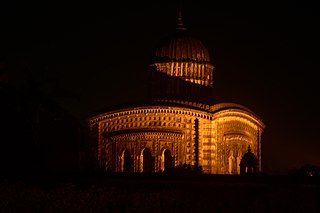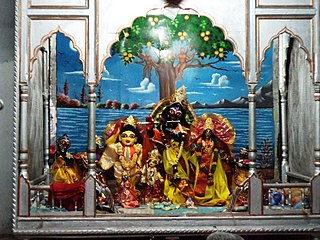
Bardhaman is a city and municipality in the state of West Bengal, India. It is the headquarters of Purba Bardhaman district, having become a district capital during the period of British rule. Burdwan, an alternative name for the city, has remained in use since then.

Kalna or Ambika Kalna is a town in the Purba Bardhaman district of West Bengal, India. It is the headquarters of the Kalna subdivision, situated on the western bank of the Bhāgirathi river. The town is more popularly known as Ambika Kalna, named after the goddess Kali, Maa Ambika. It has numerous historical monuments, such as the Rajbari, and 108 Shiva temples. The city of Kalna is 60 kilometres (37 mi) from Bardhaman.

Katwa is a sub-divisional town and railway junction in Purba Bardhaman district of the Indian state of West Bengal. It is the headquarters of the Katwa subdivision. The town was built at the confluence of Ganga and Ajay. Katwa is a border city of three districts; Purba Bardhaman District, Nadia District and Murshidabad District.

Barakar is a neighbourhood in Asansol, Paschim Bardhaman district in the Indian state of West Bengal. It is governed by the Asansol Municipal Corporation It is situated at the border of the states of Jharkhand and West Bengal. The Grand Trunk Road passes through Barakar. The neighbourhood is located on the banks of the river Barakar.

Bishnupur is a city and a municipality of Bishnupur district in the state of West Bengal, India. It is famous for its terracotta temples built by the Malla rulers, historic Radha Krishna temples built during 1600–1800 CE and the Baluchari sarees.

Chandrakona is a town and a municipality in the Ghatal subdivision of Paschim Medinipur district in the state of West Bengal, India. The city is located between Ghatal and Garhbeta. The king – Chandraketu was the founder of the kingdom of Chandrakona. In Ain-E-Akbari it was mentioned as ‘Mana’.

Ramjibanpur is a city and a municipality in the Ghatal subdivision of the Paschim Medinipur district in the Indian state of West Bengal.

Kharar is a historical town of Ghatal and one of the oldest municipality in Asia. This city is located in the Ghatal Subdivision of the Indian state of West Bengal.

Bahulara Ancient Temple is located in Bahulara village in the Onda II village panchayat, in the Onda CD block in the Bankura Sadar subdivision of the Bankura district in the Indian state of West Bengal. It is 5 km (3.1 mi) from Ondagram railway station and 25 km (16 mi) from Bishnupur.
Katwa subdivision is an administrative subdivision of the Purba Bardhaman district in the state of West Bengal, India.

Srikhanda is a village in Srikhanda gram panchayat in Katwa I CD block in Katwa subdivision of Purba Bardhaman district. It is about 8 km (5.0 mi) distance from Katwa and 48 km (30 mi) distance from Burdwan.
Katwa II is a community development block that forms an administrative division in Katwa subdivision of Purba Bardhaman district in the Indian state of West Bengal.
Sribati G.K. High School is a government high school located in Sribati, Katwa II, Bardhaman District, West Bengal, India. Established in 1867, it is one of the oldest schools in the area, and offers co-educational classes up to the tenth grade. It is the only educational institution in Sribati.

Baidyapur is a village in Kalna II CD block in Kalna subdivision of Purba Bardhaman district, West Bengal, India.
Mankar is a village in Galsi I CD Block in Bardhaman Sadar North subdivision of Purba Bardhaman district in the state of West Bengal, India.

Purba Bardhaman district is in West Bengal. Its headquarters is in Bardhaman. It was formed on 7 April 2017 after the division of the previous Bardhaman district. Great revolutionary Rash Behari Bose was born in village Subaldaha in the district of Purba Bardhaman.
Arra is a census town in the Kanksa CD block in the Durgapur subdivision of the Paschim Bardhaman district in the Indian state of West Bengal.

Gourangapur is a village in Kanksa CD block in Durgapur subdivision of Paschim Bardhaman district in the Indian state of West Bengal. The place has links with Ichhai Ghosh, king of Gopbhum, and it is believed that his capital, Dhekur, was located nearby. The area was earlier a part of Senpahari pargana.

Baidyapur Jora Deul is a 16th-century temple at Baidyapur in the Kalna II CD block in the Kalna subdivision of the Purba Bardhaman district in the Indian state of West Bengal.
Balsi Purbapara is a village in the Patrasayer CD block in the Bishnupur subdivision of the Bankura district in the state of West Bengal, India.

















